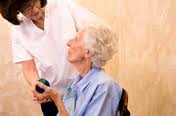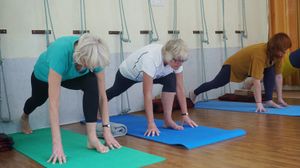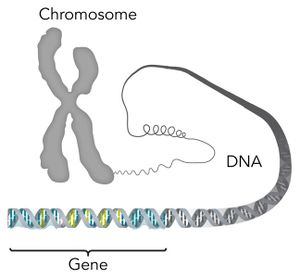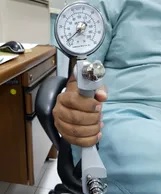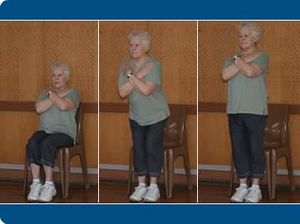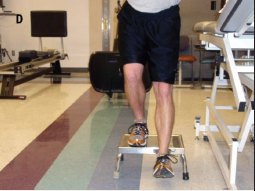Sarcopenia
Original Editor - Lucinda hampton
Top Contributors - Lucinda hampton, Saliu Balogun, Kim Jackson, Aminat Abolade and Candace Goh
Introduction[edit | edit source]
Sarcopenia is defined as being a decline in muscle function (either walking speed or grip strength) associated with loss of muscle mass[1]. Sarcopenia most commonly affects elderly and sedentary populations and patients who have comorbidities that affect the musculoskeletal system or impair physical activity[2]. Sarcopenia leads to disability, falls, and increased mortality. Loss of muscle strength and aerobic function are 2 of the hallmarks of frailty. Sarcopenia has been linked to an increased prevalence of osteoporosis, thus further increasing its propensity to produce fractures.[1]
Sarcopenia is a growing global health concern.
- Sarcopenia has been reported to affect 5-13% of persons aged 60 to 70 years and up to 50% of people over 80 years of age.
- In 2000, the number of people ≥ 60 years old around the world was estimated to be 600 million.
- This population is expected to rise to 1.2 billion by 2025 and 2 billion by 2050.
- Even with a conservative estimate of prevalence, sarcopenia affects >50 million people today and will affect >200 million in the next 40 years[3].
- Strength training should be considered a first-line treatment strategy for managing and preventing sarcopenia[4]
Risk Factors[edit | edit source]
Sarcopenia is considered by most to be an inevitable part of aging. However, the degree of sarcopenia is highly variable and is dependent upon presence of certain risk factors:
- Physical Inactivity:
- Lack of exercise is believed to be the foremost risk factor for sarcopenia. A gradual decline in myocyte numbers begins around 50 years of age. The decline in muscle fiber and strength is more pronounced in patients with sedentary lifestyle as compared to patients who are physically more active. Even professional athletes such as marathon runners and weight lifters show a gradual (more slow) decline in their speed and strength with aging.
- Hormone and Cytokine Imbalance:
- Age-related decreases in hormone concentrations (eg testosterone, thyroid hormone and insulin-like growth factor) lead to loss of muscle mass and strength. Extreme muscle loss often results from a combination of diminishing hormonal anabolic signals and promotion of catabolic signals mediated through pro-inflammatory cytokines.
- Protein Synthesis and Regeneration:
- A decrease in the body's ability to synthesize protein, coupled with inadequate intake of calories and/or protein to sustain muscle mass, is common in sarcopenia. Oxidized proteins increase in skeletal muscle with aging and lead to a buildup of lipofuscin (yellowish brown, pigmented, insoluble granules).[5]The age-related increase in amounts of oxidized protein may reflect the age-dependent accumulation of unrepaired DNA damage that affects the concentrations or activities of numerous factors that govern the rates of protein oxidation and the degradation of oxidized protein[6]. This accumulation of non-contractile dysfunctional protein in skeletal muscles is part of the reason muscle strength decreases severely in sarcopenia.
- Motor Unit Remodelling:
- Age-related reduction in motor nerve cells responsible for sending signals from the brain to the muscles to initiate movement also occurs. Satellite cells are small mononuclear cells that abut muscle fibers and are normally activated upon injury or exercise. In response to these signals, satellite cells differentiate and fuse into the muscle fiber, helping to maintain muscle function. One current hypothesis is that sarcopenia is caused, in part, by a failure in satellite cell activation. [3]
Histopathology[edit | edit source]
Early sarcopenia is characterized by a decrease in the size of muscle and muscle tissue. Changes include:
- Replacement of muscle fibers with fat, an increase in fibrosis, changes in muscle metabolism, oxidative stress, and degeneration of the neuromuscular junction.
- This ultimately leads to progressive loss of muscle function and to frailty.
- Sarcopenia predominantly effects the type II (fast twitch) muscle fibers, type I (slow twitch) fibers are much less affected.
- Sarcopenia represents both a reduction in muscle fiber number as well as reduced fiber size.
- Histological studies comparing muscle cross-sections of elderly with those of younger individuals reveal at least 50% fewer type I and type II fibers by the ninth decade[3].
Screening Tools to Identify Probable Sarcopenia[edit | edit source]
The SARC-F (Strength, assistance with walking, rising from a chair, climbing stairs, and falls) questionnaire
Assessing sarcopenia: muscle strength
- Handgrip test: Generally, handgrip strength is one of the two methods utilized to quantify muscle strength in patients with suspected sarcopenia. Handgrip strength correlates with strength in other muscles and is therefore used as a surrogate to detect deficits in overall strength.
- Chair stand test: The chair stand test may be used as a proxy to gauge lower extremity strength, particularly the quadriceps muscles[2].
Suggested tests for sarcopenia severity include:
Pharmacological Treatment[edit | edit source]
Currently, there are no agents for the treatment of sarcopenia that have been FDA approved.
- DHEA and human growth hormone have little to no effect. Growth hormone increases muscle protein synthesis and increases muscle mass but does not lead to gains in strength and function.
- Testosterone or other anabolic steroids have a modest positive effect on muscle strength and mass but are of limited use due to adverse effects, such as increased risk of prostate cancer in men, virilization in women, and an overall increased risk of cardiovascular events.
- New therapies for sarcopenia are in clinical development. Selective androgen receptor modulators (SARMs) are of particular interest because of their tissue selectivity. Other compounds under investigation as treatments for sarcopenia include myostatin, vitamin D, angiotensin converting enzyme inhibitors, omega-3 supplements, and anabolic agents such as ghrelin and its analogues.
Management Physiotherapy[edit | edit source]
Early recognition and intervention is the key to improved outcomes in patients with sarcopenia.
- Screening patients for impairment in their physical function and activities of daily living (ADLs) should be a routine part of healthcare visits for the elderly.
- Assessment of patients’ environments for fall hazards and implementation of precautionary safety measures should be part of the treatment strategy.
An exercise regimen is considered a cornerstone in the treatment of sarcopenia.
- A well-designed, progressive resistance exercise training program is well known to exert positive effects on both the nervous and muscular systems and, ultimately, results in profound enhancements in muscle mass and muscle strength.
- Strength exercise training should be considered a first-line treatment strategy for managing and preventing both sarcopenia.
- Short-term resistance exercise has been demonstrated to increase ability and capacity of skeletal muscle to synthesize proteins.
- Both resistance training (RT) and strength training (ST) of muscles have been shown to be somewhat successful interventions in the prevention and treatment of sarcopenia. RT has been reported to positively influence the neuromuscular system as well as increase hormone concentrations and the rate of protein synthesis.[3].[4]
The greatest effects are observed when resistance training and high protein diets are combined and appear to act synergistically.
- Specifically, consuming 20-35 grams of protein per meal is advised, as such amounts provide sufficient amino acid content to maximize MPS, thus minimizing age-related muscle loss. eg Chicken Breast: 23.1 g Protein Per 100 g, Canned Tuna: 23.6 g Protein Per 100 g, Cocoa: 20 g Protein Per 100 g, Cheddar Cheese: 24.9 g Protein Per 100 g.Beef Jerky: 33.2 g Protein Per 100 g.[7]
- Additionally, patients with sarcopenia are recommended to consume 1.0 - 1.2 g/kg (body weight)/day[2].
Last Image R: protein shake with dumbells.
References[edit | edit source]
- ↑ 1.0 1.1 Malmstrom TK, Morley JE. SARC-F: a simple questionnaire to rapidly diagnose sarcopenia. Journal of the American Medical Directors Association. 2013 Aug 1;14(8):531-2.Available from: https://www.researchgate.net/publication/243966215_SARC-F_A_Simple_Questionnaire_to_Rapidly_Diagnose_Sarcopenia (accessed 9.3.2021)
- ↑ 2.0 2.1 2.2 Ardeljan AD, Hurezeanu R. Sarcopenia. StatPearls [Internet]. 2020 Jul 10. Available from:https://www.ncbi.nlm.nih.gov/books/NBK560813/ (accessed 9.3.2021)
- ↑ 3.0 3.1 3.2 3.3 Dhillon RJ, Hasni S. Pathogenesis and management of sarcopenia. Clinics in geriatric medicine. 2017 Feb 1;33(1):17-26.Available from: https://www.ncbi.nlm.nih.gov/pmc/articles/PMC5127276/(accessed 9.3.2021)
- ↑ 4.0 4.1 Clark BC, Clark LA, Law TD. Resistance exercise to prevent and manage sarcopenia and dynapenia. Annual Review of Gerontology and Geriatrics. 2016 Jan 1;36(1):205-28.Available from:https://www.ncbi.nlm.nih.gov/pmc/articles/PMC4849483/ (accessed 9.3.2021)
- ↑ Lipofuscin Medical Definition | Merriam-Webster Medical Dictionary
- ↑ Stadtman ER. Protein oxidation and aging. Science. 1992 Aug 28;257(5074):1220-4.Available from: https://science.sciencemag.org/content/257/5074/1220(accessed 10.3.2021)
- ↑ Nutrition advance The 20 Highest Protein Foods Per 100 Grams Available from: https://www.nutritionadvance.com/highest-protein-foods-per-100-grams/ (accessed 10.3.2021)
